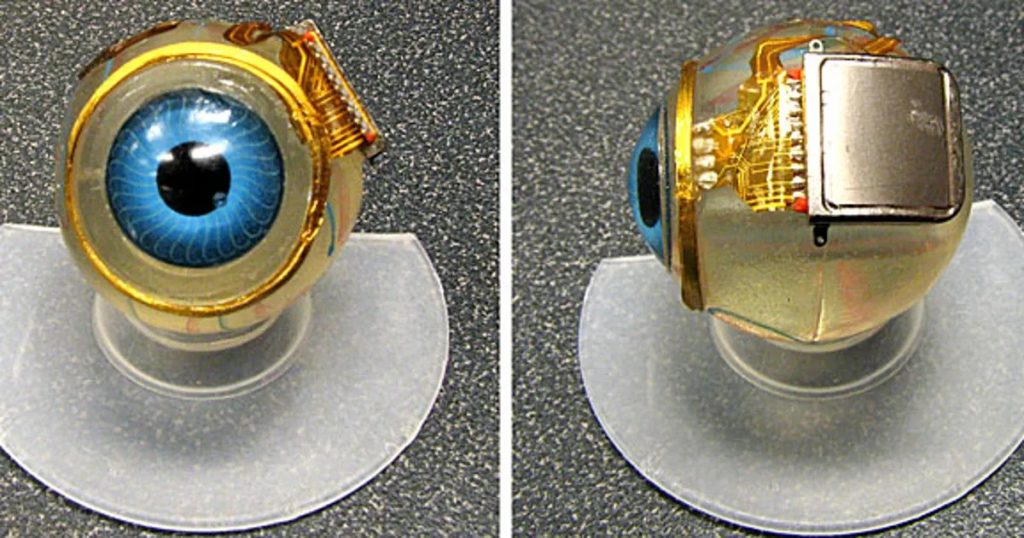
‘Gennaris Bionic Eye Vision System’
Arthur Lowery, a professor at Monash University’s Department of Electrical and Computer Systems Engineering, which manufactured the bionic eye, said in a statement, “Our design creates a visual pattern from combinations of up to 172 spots of light (phosphenes) which provides information for the individual to navigate indoor and outdoor environments, and recognize the presence of people and objects around them.”
Scientists build ‘Bionic Eye’ to restore vision in blind people – Insider Paper
The Gennaris Bionic Eye Vision System is a groundbreaking technology that aims to restore sight to those who have lost it. It is a bionic eye implant that has been developed by scientists from Australia’s Monash University and the Hong Kong University of Science and Technology.
The Gennaris Bionic Eye Vision System is a wireless, implantable device that bypasses the damaged parts of the eye and directly stimulates the optic nerve. The device consists of a pair of glasses that have a camera mounted on them, which captures visual information in real-time. This information is then transmitted wirelessly to a small implant that is placed on the back of the patient’s head.
The implant is a small chip that contains an array of electrodes that are able to stimulate the optic nerve in a way that mimics the way the eye normally works. This allows the brain to receive visual information and create a visual image, enabling the patient to see again.
One of the most significant advantages of the Gennaris Bionic Eye Vision System is that it is completely wireless. This means that there are no external wires or cables, making the device much more comfortable for the patient to wear. The device is also designed to be very energy-efficient, with a battery life of up to 10 years.
The Gennaris Bionic Eye Vision System has undergone extensive testing and has shown very promising results. In a recent trial, patients who received the implant were able to correctly identify shapes and letters on a screen and even read short sentences. This represents a significant improvement in their quality of life and independence.
The Gennaris Bionic Eye Vision System has the potential to transform the lives of millions of people around the world who have lost sight due to a range of conditions, including age-related macular degeneration, retinitis pigmentosa, and glaucoma. The device is still in the early stages of development, but it is already showing great promise.
the Gennaris Bionic Eye Vision System has the potential to restore sight to those who have lost it. This wireless, implantable device is designed to bypass the damaged parts of the eye and directly stimulate the optic nerve, allowing patients to see again. While the device is still in the early stages of development, it has shown very promising results and has the potential to transform the lives of millions of people around the world.
Costs To Produce Bionic Eyes
An accurate estimate of the cost to produce bionic eyes as it depends on a number of factors, such as the complexity of the device, the materials used, the manufacturing process, and the regulatory requirements for medical devices.
The Gennaris Bionic Eye Vision System, for example, is still in the early stages of development and it is unclear what the final cost of the device will be. However, the researchers behind the technology have stated that they are aiming to make it affordable and accessible to as many people as possible.
In general, the cost of medical devices can be quite high due to the research and development, manufacturing, and regulatory costs involved. However, as technology advances and becomes more widely adopted, the cost of production may decrease over time.
It is also worth noting that the cost of bionic eyes may be covered by health insurance or government programs, depending on the country and the specific circumstances of the patient.
Overall, while the cost of producing bionic eyes is currently unclear, the potential benefits to patients who have lost their vision are significant and may justify the investment in this technology.
How much funding would be needed to produce bionic eyes
The amount of funding needed to produce bionic eyes would depend on the scope and scale of the project. Developing a bionic eye is a complex process that involves a significant amount of research and development, clinical trials, regulatory approvals, and manufacturing.
Several factors can influence the total cost of developing bionic eyes, such as the number of researchers and engineers involved, the cost of equipment and materials, the duration of the project, and the regulatory requirements in different countries.
For example, the Gennaris Bionic Eye Vision System has received funding from various sources, including the Australian Research Council, the National Health and Medical Research Council, and the Australian government’s Medical Research Future Fund. The project has also received investment from private companies.
According to media reports, the Gennaris project has received a total of AUD 30 million in funding since its inception. This funding has enabled the researchers to develop a prototype of the device and conduct early clinical trials.
Overall, the amount of funding needed to develop bionic eyes would depend on the scope and complexity of the project, as well as the availability of funding from various sources. Given the potential benefits of bionic eyes in restoring vision to people who are blind or visually impaired, it is likely that significant investment will be required to bring this technology to fruition.
Who would get the bionic eyes once they have been manufactured?
Bionic eyes, once they have been manufactured, would likely be made available to people who are blind or visually impaired due to a range of conditions, including age-related macular degeneration, retinitis pigmentosa, and glaucoma. The primary goal of developing bionic eyes is to provide a viable treatment option for people who have lost their vision and to help them regain some level of functional vision.
In general, the use of bionic eyes would be determined on a case-by-case basis, depending on the specific circumstances of the individual patient. For example, patients who have lost their vision due to damage to the retina may be good candidates for a bionic eye that directly stimulates the optic nerve. Other patients with different types of vision loss may require different types of bionic eyes or other types of vision restoration technologies.
It is worth noting that the development and deployment of bionic eyes would likely require significant regulatory oversight to ensure that the devices are safe and effective for patients. In most countries, medical devices such as bionic eyes must undergo rigorous testing and clinical trials before they can be approved for use in patients.
Overall, the development of bionic eyes has the potential to provide a much-needed treatment option for people who are blind or visually impaired. While the technology is still in the early stages of development, it is already showing great promise, and it is likely that bionic eyes will become more widely available as the technology advances and becomes more accessible.

#bioniceye #eyesight #opticalnerve #restoreeyesight #blindness #blind #visuallyimpaired #gennaris
Renata The Owner & Editor of DisabledEntrepreneur.uk and DisabilityUK.co.uk Online Journals, suffers From OCD, Cerebellar Atrophy & Rheumatoid Arthritis. She is an Entrepreneur & Published Author, she writes content on a range of topics, including politics, current affairs, health and business. She is an advocate for Mental Health, Human Rights & Disability Discrimination.
Whilst her disabilities can be challenging she has adapted her life around her health and documents her journey online.
Disabled Entrepreneur - Disability UK Online Journal Offers Digital Marketing, Content Writing, Website Creation, SEO, and Domain Brokering. Disabled Entrepreneur - Disability UK is an open platform that invites contributors to write articles and serves as a dynamic marketplace where a diverse range of talents and offerings can converge. This platform acts as a collaborative space where individuals or businesses can share their expertise, creativity, and products with a broader audience.










Leave a Reply
You must be logged in to post a comment.